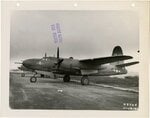UPDATE: This thread has been discontinued and is full of incorrect information. For more current (and more accurate) information, see the thread B-26 Engineering Data/Technical Information (From Martin's Own Blueprints).
Hi all,
One of the multiple projects I've been trying to work on recently is building a 3d model of the early short wing B-26 Marauder (B-26, B-26A, B-26B-1 through B-26B-4, Marauder Mk. I), specifically the first production version, though modifying it to represent the other early versions wouldn't be too difficult after the model is finished. I've been doing research on the B-26 on and off since around 2016, and with my B-32 blueprints stuck in Daytona and 3 months with little to do before I can return, I figured I should get started on it. I've acquired quite a few manuals and diagrams, but my main obstacle seems to be the same as it was for the B-32: putting the pieces together. I have station diagrams and general arrangement drawings, but none list the size (height and width) of the fuselage's many frames and bulkheads, the few mentions often rounding up numbers, or just being very wrong. The documents also don't mention where the attachment points for the landing gear are, or at what height floors are mounted, that sort of stuff.
So I'm looking for any documents or diagrams that contain that missing information, that being the dimensions for the fuselage frames & bulkheads, landing gear assembly (and where the attachment points are), and any other parts I can come across. I'm also looking for one factory drawing in particular, but am not sure where to look. Thanks to Andrew Boehly at the Pima Air & Space Museum, I have a photo of an early inboard profile for the B-26, drawing number AP-B-26-075, but unfortunately only one sheet out of the 4 of the original drawing as the museum does not have the other ones. I'm trying to find the missing sheets.
I've contacted Stan Piet at the Glenn L. Martin Museum, and he has informed me that they do not have any manufacturer's diagrams for the Marauder. I plan on contacting the Smithsonian again when I am able, however since their replies are in the form of physical mail I wouldn't be able to receive anything until August.
Sorry if this post is a little rambly or oddly formatted, in general I'm creating this thread as a means to document my research into the Marauder and find additional information on it.
And speaking of documenting, I'm attaching the Excel file where I'm currently writing down what is located at what station on the plane and other information like that. I'm still filling it out, so quite a few entries are empty
Thanks for reading,
-Matt
Hi all,
One of the multiple projects I've been trying to work on recently is building a 3d model of the early short wing B-26 Marauder (B-26, B-26A, B-26B-1 through B-26B-4, Marauder Mk. I), specifically the first production version, though modifying it to represent the other early versions wouldn't be too difficult after the model is finished. I've been doing research on the B-26 on and off since around 2016, and with my B-32 blueprints stuck in Daytona and 3 months with little to do before I can return, I figured I should get started on it. I've acquired quite a few manuals and diagrams, but my main obstacle seems to be the same as it was for the B-32: putting the pieces together. I have station diagrams and general arrangement drawings, but none list the size (height and width) of the fuselage's many frames and bulkheads, the few mentions often rounding up numbers, or just being very wrong. The documents also don't mention where the attachment points for the landing gear are, or at what height floors are mounted, that sort of stuff.
So I'm looking for any documents or diagrams that contain that missing information, that being the dimensions for the fuselage frames & bulkheads, landing gear assembly (and where the attachment points are), and any other parts I can come across. I'm also looking for one factory drawing in particular, but am not sure where to look. Thanks to Andrew Boehly at the Pima Air & Space Museum, I have a photo of an early inboard profile for the B-26, drawing number AP-B-26-075, but unfortunately only one sheet out of the 4 of the original drawing as the museum does not have the other ones. I'm trying to find the missing sheets.
I've contacted Stan Piet at the Glenn L. Martin Museum, and he has informed me that they do not have any manufacturer's diagrams for the Marauder. I plan on contacting the Smithsonian again when I am able, however since their replies are in the form of physical mail I wouldn't be able to receive anything until August.
Sorry if this post is a little rambly or oddly formatted, in general I'm creating this thread as a means to document my research into the Marauder and find additional information on it.
And speaking of documenting, I'm attaching the Excel file where I'm currently writing down what is located at what station on the plane and other information like that. I'm still filling it out, so quite a few entries are empty
Thanks for reading,
-Matt
Attachments
Last edited:














